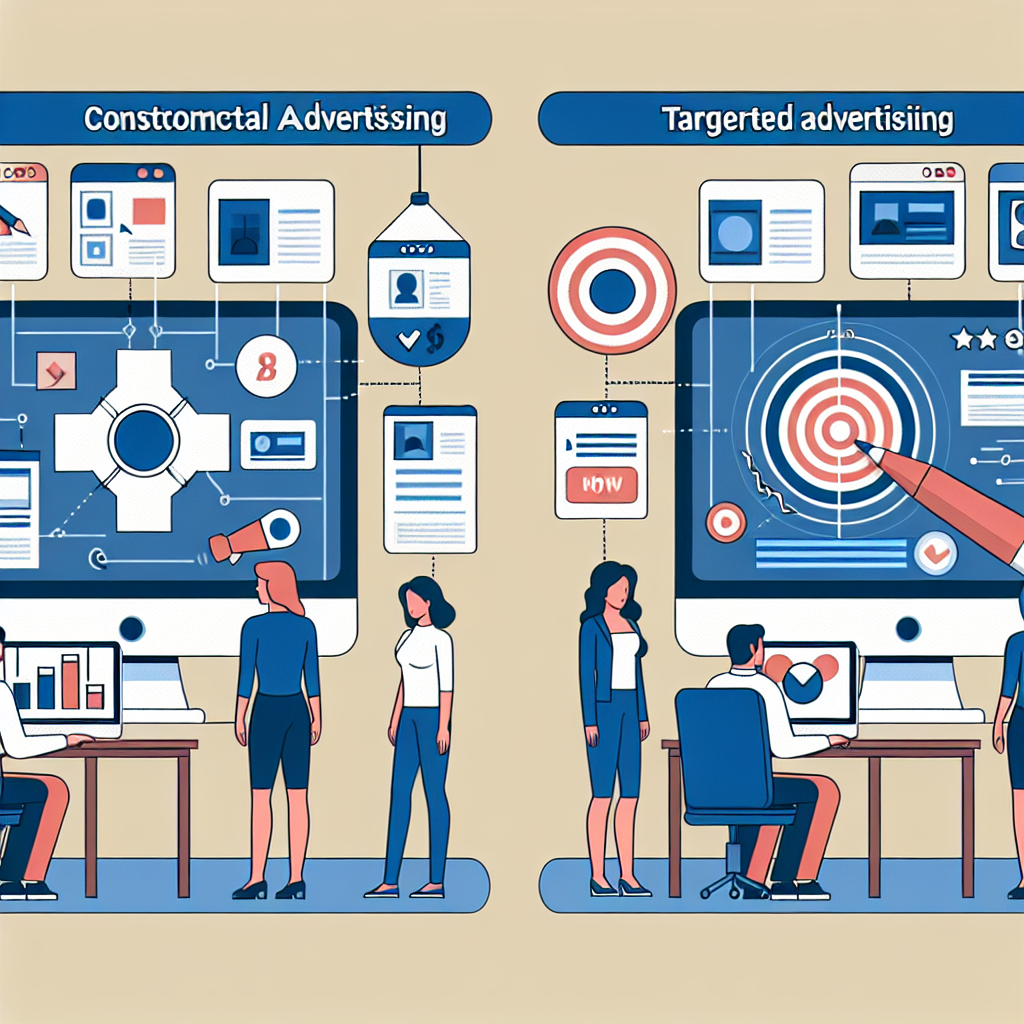
When businesses consider their advertising strategies, a common question arises: Which is more expensive: contextual advertising or targeting? The answer involves not only the costs associated with each but also how effectively they meet the companys goals. Lets break it down! ⭐
Contextual advertising involves placing ads on web pages that are directly relevant to the content displayed. For instance, if a user is reading a tech review, they might see ads for laptops or software solutions. Its a strategy that leverages keywords to ensure that ads are seen by an interested audience, hence potentially increasing conversion rates. ⭐
On the other hand, targeting refers to delivering ads to a specific audience based on demographics, interests, and online behavior. For example, if a company sells athletic wear, they might target users who have previously visited sports-related websites or those who follow fitness influencers. This adds a layer of precision that can be highly beneficial! ⭐
Now, lets dive into the costs associated with both strategies. Heres a comparative table that illustrates the expenses involved:
| Service | Cost (EUR) |
| Google Adwords - Initial Setup | 200 |
| Google Adwords - Monthly Support | 50 + 10% of budget |
| Google Adwords - Banner for Advertising | 70 |
| SEO Promotion - 10 Keywords | 349 |
| SMM Promotion - BEGIN Package | 649 |
| Email Newsletter - Premium | 789 |
| Viber Newsletter - Standard | 359 |
| Online Store Development | 4500 |
| Website Support - Maximum Package (40 hours) | 680 |
| Landing Page Development on WordPress | 1560 |
As you can see, contextual advertising can start with lower initial costs, but variable monthly expenditures can add up, especially with larger campaigns. Conversely, targeting may have higher upfront costs for setup and creation but can lead to more efficient spending over time.
Lets look at a case study to better understand how these costs manifest in real life:
A local sports equipment retailer decided to launch a new line of fitness gear. They opted for contextual advertising in a popular fitness blog. For an initial investment of €200, they saw a surprisingly low click-through rate (CTR) since their ad only reached users engaged with specific articles. This meant that even though the cost per click seemed low, many users werent interested in purchasing the products. After spending €600 over a month, they generated just one sale from their ads.
In contrast, a tech startup that sells software solutions invested in a targeted email marketing campaign. By reaching out to a segmented audience of software developers, their €500 investment resulted in 30 new subscriptions. This scenario demonstrates that while targeting might seem costlier upfront, it often translates to a higher return! ⭐
Industry experts suggest regularly reviewing your advertising strategies to evaluate whats yielding results. Arsenii, our customer relations manager, states: "Many businesses overlook the hidden costs associated with contextual advertising, including the expenses for optimized ad content and ongoing adjustments." He emphasizes the importance of strategy in minimizing these expenses.
Ultimately, the question of which is more expensive: contextual advertising or targeting hinges on your business objectives and target audience. We recommend conducting a thorough analysis of both methods and leaning towards the one that aligns best with your long-term goals. If you’re having trouble deciding or need assistance managing your IT systems, our team at webmaster.md has over 20 years of experience in providing comprehensive solutions tailored to your needs. ⭐
Don’t hesitate to reach out! Call us at +373 601 066 66 or visit our website to see how we can help you maximize your investment in advertising. Lets work together to find the best solution for your business!

When it comes to crafting an effective advertising strategy, the decision between contextual advertising and targeting isn’t just a matter of preference—it directly impacts your bottom line. ⭐ In this chapter, we’ll explore why this decision is crucial for your budget and overall success.
The costs associated with contextual advertising and targeting can vary significantly. Contextual advertising relies on the relevance of the content to place ads, which can lead to fluctuations in performance and, consequently, costs. For example, a company might spend €300 on contextual ads that only reach users casually interested in their products, resulting in a low conversion rate. ⭐
In contrast, targeting allows you to zone in on specific demographics, interests, or behaviors. This precision often leads to a better return on investment (ROI). Consider that a recent study showed targeted ads had an average CTR of 3%, while contextual ads hovered around 1.5%. ⭐ If you spend €500 on a targeted campaign, youre likely to get more conversions than if that same amount were spent on a contextual strategy.
Let’s look at scenarios that highlight the financial effects of choosing between these two strategies:
This clearly indicates that while contextual advertising might seem less expensive at a glance, its efficiency in converting viewers into customers is far lower compared to targeting. ⭐
When you think about your overall advertising spending, consider not just initial costs but ongoing expenses. While the upfront costs for targeting may be higher, the resulting conversion rates can greatly reduce long-term costs by bringing in loyal customers who repeatedly purchase your products or services. ⭐
Here’s why:
At webmaster.md, we have encountered clients who struggled with their advertising choices:
One client, a fitness center, initially poured money into a contextual advertising campaign, hoping it would attract local members. After wasting €750 without yielding significant results, they consulted us, and we suggested a targeted approach. Within 2 months of targeting users interested in fitness and health, their sign-ups surged, and they reported a 30% increase in membership. This demonstrates that your budget can be optimized through informed choices.
Renowned marketing analyst Arsenii emphasizes, "Businesses underestimate the power of targeted strategies. Investing thoughtfully leads to better insights and ultimately, a healthier budget." ⭐ When experts weigh in, its clear that choosing the right strategy is vital for both immediate impact and future financial health.
In summary, your decision between contextual advertising and targeting doesn’t just affect your current marketing campaign; it influences your overall budget and financial sustainability. Understanding these elements ensures that you are not just spending money but investing wisely in your business’s growth. ⭐
If you need help navigating these options or managing your IT systems more effectively, don’t hesitate to reach out! You can contact us at +373 601 066 66 or visit our website today to discover how we can maximize your advertising efforts.

Understanding the costs associated with advertising strategies is crucial for any business owner. In this chapter, we will dissect how to evaluate the financial implications of contextual advertising versus targeting using real-world examples. By the end of this section, you will have a clearer understanding of which method might be more cost-effective for your specific needs. ⭐
Before diving into the specifics, let’s establish what we mean by costs. When evaluating advertising strategies, consider several factors:
Consider a local coffee shop that decides to use contextual advertising on food-related websites. They spent €200 on ads that displayed alongside articles about coffee brewing techniques.
While the ads were seen by thousands, only 10 customers made purchases resulting in a CPA of €20. ⭐ The shop realized that while they attracted attention, they weren’t reaching the right audience.
After this campaign, their total ad expense was:
With this, they ended up with an ROI of -25%. So, what went wrong? The content wasn’t a perfect match for their ideal customer profile, leading to lower conversions.
Now, let’s look at a different scenario. A tech company specializing in software solutions decides to invest in a targeting strategy on social media. They choose to focus on users who fit a specific profile: tech enthusiasts aged 25-40 who follow certain influential figures in the industry.
With an investment of €500, they created tailored ads and targeted 10,000 users directly.
The results were promising:
Here, the CPA came to just €10! The ROI was a whopping 200%! ⭐ Despite higher upfront costs, this targeted campaign matched the message to the audience effectively, leading to greater engagement and revenue.
To summarize the cost evaluations of both strategies, let’s look at a comparison table:
| Advertising Strategy | Initial Cost (EUR) | Total Revenue (EUR) | Customers Acquired | CPA (EUR) | ROI |
| Contextual Advertising | 400 | 300 | 10 | 20 | -25% |
| Targeting | 500 | 1,500 | 50 | 10 | 200% |
The evaluation of costs reveals significant differences:
Marketing strategist Arsenii notes, "It’s not always about how much you spend, but how effectively you can convert that investment into tangible results. Testing and analyzing performance will guide you toward optimal strategies." ⭐
If you find yourself in a dilemma choosing between contextual advertising and targeting, don’t hesitate to reach out to us! Our experienced team at webmaster.md can help you navigate through the complexities to maximize your budget and results. Call us today at +373 601 066 66 or visit our website for more information. Lets unleash your advertising potential together! ⭐

When it comes to understanding costs associated with contextual advertising and targeting strategies, misconceptions abound. Many businesses step into the advertising world with preconceived notions, often overlooking hidden expenses that can impact their overall budget. In this chapter, we’ll debunk these myths and shine a light on the true costs associated with each strategy. ⭐
One of the biggest myths is that contextual advertising is a low-cost option. While the initial costs may appear reasonable, many advertisers fail to consider ongoing expenses that pile up. For example, creating and optimizing ad content can incur additional costs that may not be immediately evident. Advertising platforms often charge for clicks, impressions, and even ad placements, which means the total investment can soar if the campaign is not effectively targeted. ⭐
A travel agency once invested €400 in contextual advertising on a leading travel blog. They assumed that the blogs massive audience would lead to high engagement, but after analyzing the results, they found that only 2 actual bookings occurred. Hidden costs for creating and managing ads pushed their CPA to €200 per customer—much higher than expected. This highlights the importance of setting a realistic budget that considers these hidden expenses.
Many believe that targeting is exclusively about defining demographics — age, gender, or location. However, successful targeting also requires an in-depth understanding of customer behavior, interests, and preferences. This often involves significant upfront investments in research and analytics. Clients might overlook expenses associated with gathering this data, including surveys and consumer analysis tools. ⭐
Consider a clothing retailer that spent €400 on demographic-targeted ads. While they brought in some traffic, they soon realized many of the visitors were not interested in their products. They had neglected to account for the cost of comprehensive customer research, which would have provided deeper insights into their potential audience. An effective targeted approach might include an additional €300 for audience analysis tools, which, while initially more expensive, could have resulted in a more engaged customer base.
It’s easy to fall into the trap of thinking that once an advertising campaign is set up, it will run smoothly without any further investment. This notion is dangerous and misleading. Both contextual advertising and targeting require ongoing monitoring and adjustment to remain effective. Failing to do so can result in wasted costs on poorly performing ads. ⭐
A software firm launched an ad campaign with enthusiasm but didn’t revisit it for three months. They spent €600 on contextual advertising that became increasingly irrelevant over time, resulting in dismal click-through rates. When they finally checked, they realized they wasted nearly half their budget on ineffective ads. Regular reviews and adjustments could have helped them save a significant amount and refocus their budget on better-performing strategies.
Another common misconception is that simply increasing the advertising budget will lead to better results. However, inefficient ad placements based on broader contextual strategies or inaccurate targeting can lead to a poor ROI, regardless of how much money is spent. Effective advertising requires both budget allocation and strategic execution. ⭐
A tech startup that focused on contextual advertising decided to double their budget from €500 to €1000, hoping it would enhance visibility. Unfortunately, their results didn’t improve because they didn’t optimize their ad messages or select appropriate placement, leading to only two additional conversions. This example teaches us that more money often doesn’t equate to more success without a solid foundation of strategy.
Industry expert Arsenii emphasizes the need for proper planning: "Most businesses need to understand that hidden costs can sink their advertising efforts. Regular evaluation of performance metrics and audience insights is crucial for managing these expenses effectively." ⭐
By debunking these myths, it becomes clear that both contextual advertising and targeting come with their own hidden expenses that potential advertisers must consider. The key lies in thorough research, constant monitoring, and a willingness to adapt strategies based on the data at hand. If you need help managing your advertising strategies effectively, webmaster.md is here to support you. With over 20 years of experience and a team of dedicated specialists, we can help you navigate these complexities to maximize your investment. Don’t hesitate to reach out at +373 601 066 66 or visit our website! ⭐
Leaders in the IT market |
| 14+ years of experience and innovative solutions to help your business stand out and grow. |
Inspiring portfolio |
| 150+ successful projects: from sleek landing pages to complex corporate systems. |
Team of experts |
| 51+ professionals who bring your ideas to life with maximum efficiency. |

| NOTORIUM TRADEMARK AWARDS |
| Notorium Trophy 2017, Notorium Gold Medal 2018, Notorium Gold Medal 2019 |

| TRADE MARK OF THE YEAR |
| Gold Medal 2016, Gold Medal 2017, Gold Medal 2018, Gold Medal 2019 |

| THE BEST EMPLOYER OF THE YEAR |
| According to the annual Survey conducted by AXA Management Consulting - 2017, 2018, 2019 |